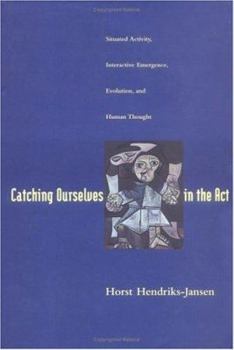Catching Ourselves in the ACT: Situated Activity, Interactive Emergence, Evolution, and Human Thought
(Part of the Complex Adaptive Systems Series)
Catching Ourselves in the Act uses situated robotics, ethology, and developmental psychology to erect a new framework for explaining human behavior. Rejecting the cognitive science orthodoxy that formal task-descriptions and their implementation are fundamental to an explanation of mind, Horst Hendriks-Jansen argues for an alternative model based on the notion of interactive emergence. Situated activity and interactive emergence are concepts that derive from the new discipline of autonomous agent research. Hendriks-Jansen puts these notions on a firm philosophical basis and uses them to anchor a "genetic" or "historical" explanation of mental phenomena in species-typical activity patterns that have been selected by a cultural environment of artifacts, language, and intentional scaffolding by adults. Situated robotics, allied with techniques and principles from ethology, allows the testing of hypotheses framed in terms of natural kinds that can be grounded through the theory of natural selection. This approach negotiates the "nature versus nurture" dispute in a radically new way. Catching Ourselves in the Act provides a thorough overview of autonomous agent research in America and Europe, focusing in particular on work by such eminent researchers as Rodney Brooks, Pattie Maes, Maja Mataric, and Rolf Pfeifer. It reassesses the basic principles of artificial life and explores the repercussions of autonomous agent research for human psychology and the philosophy of mind, as well as its affinities with the "contextual revolution" in sociology and anthropology. A Bradford Book. Complex Adaptive Systems
Format:Hardcover
Language:English
ISBN:0262082462
ISBN13:9780262082464
Release Date:June 1996
Publisher:Bradford Book
Length:379 Pages
Weight:0.15 lbs.
Dimensions:1.0" x 6.2" x 9.2"
Age Range:18 years and up
Grade Range:Postsecondary and higher
Customer Reviews
1 rating
Brings latest arguments in the lit together in one place
Published by Thriftbooks.com User , 25 years ago
Horst Hendriks-Jansen demonstrates a clear understanding of all the modern arguments about the nature of intelligence and how they relate to each other. He has a clear and logical writing style that explains and debunks many important theories. Although many of these theories and criticisisms have appeared in other places, this book brings them all together and relates them. He describes his theory of interactive emergence and the notion of language as scaffolding for learning. This weaves together many contemporary ideas into a consistient whole. A great deal of the book is devoted to debunking existing theories - I would have liked to see a more detailed exploration of interactive emergence and how language as scaffolding might work. Definitely worth a read, especially if you are interested in clear arguments against symbol-systems hypothesis etc.






